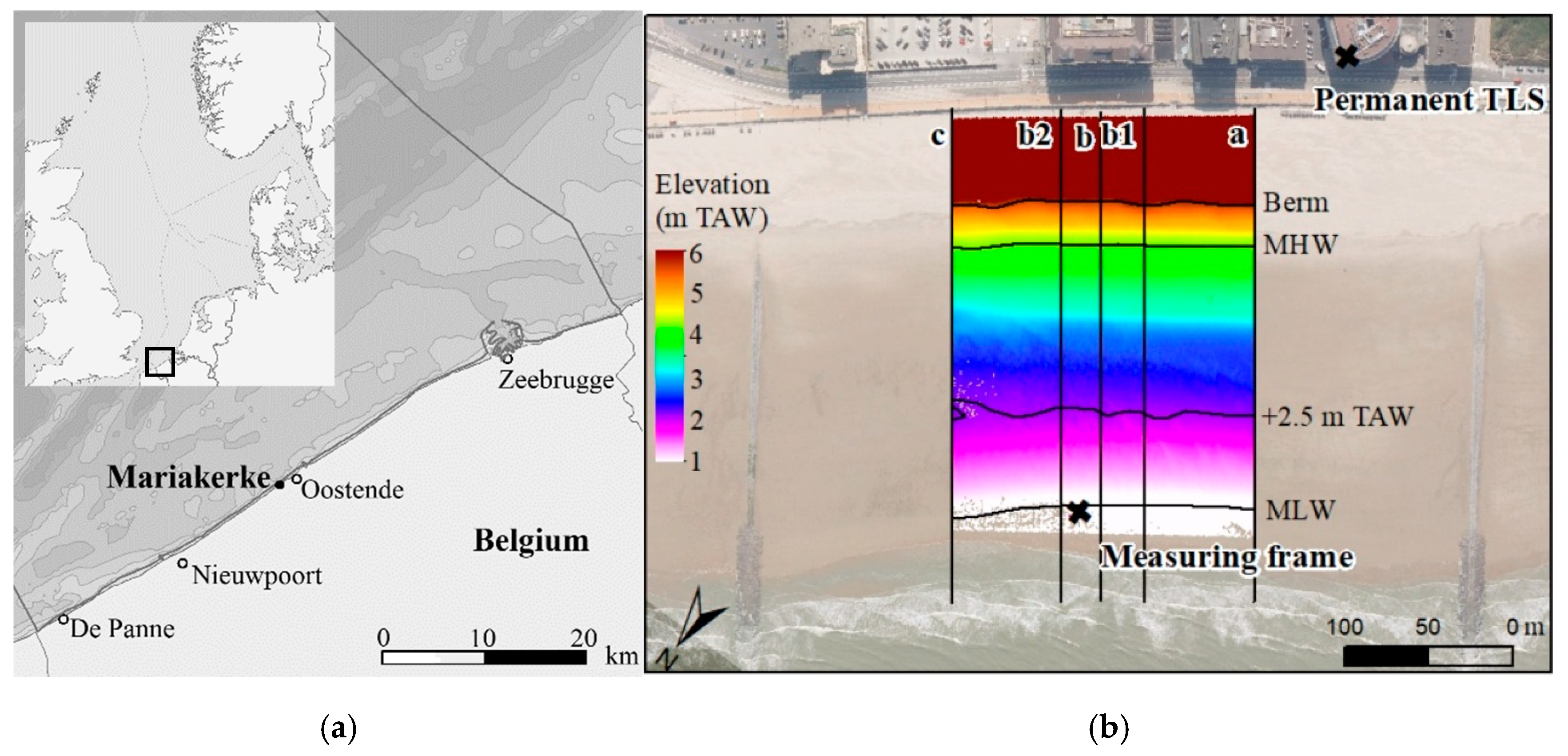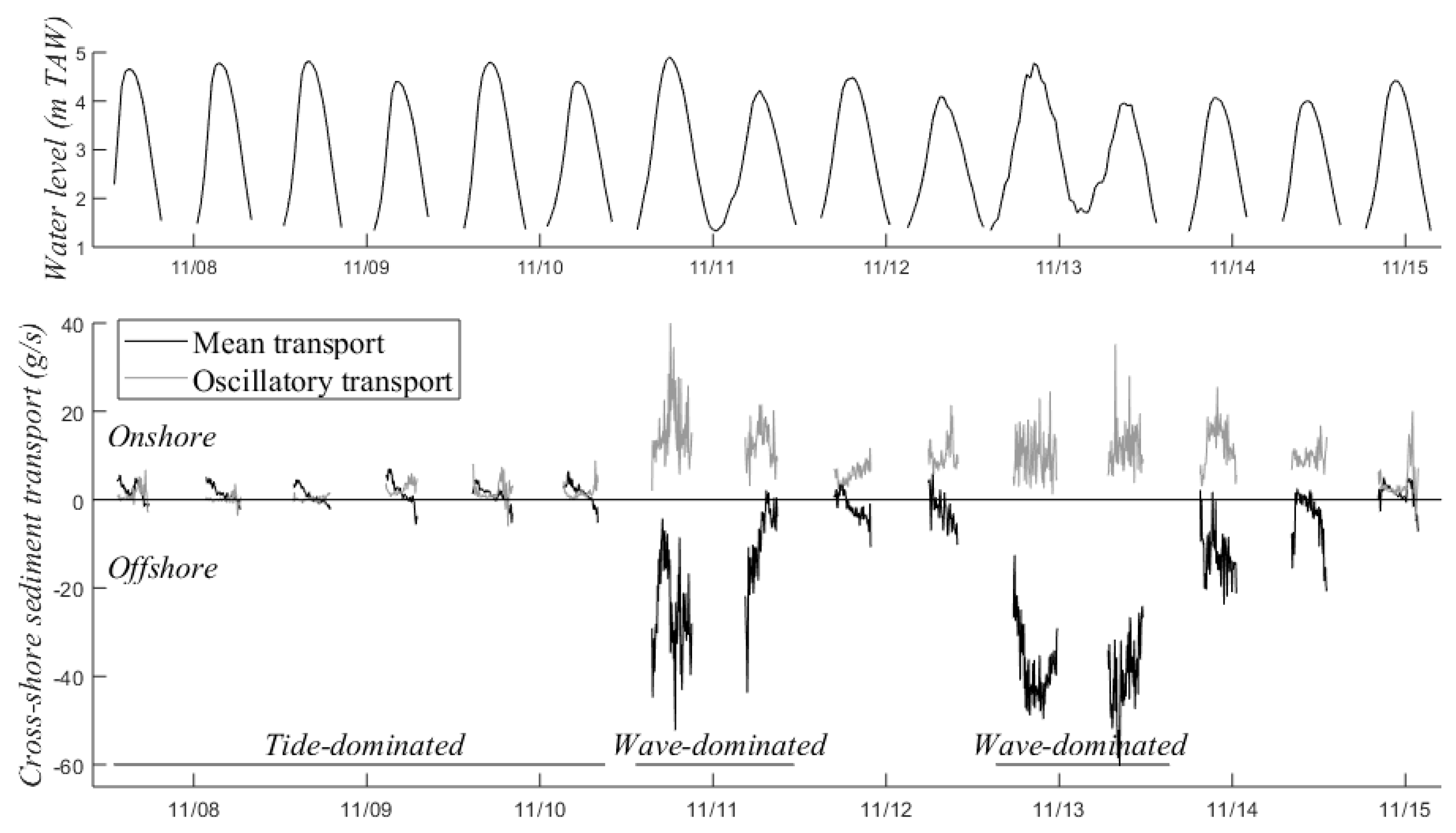Cross-Shore Suspended Sediment Transport in Relation to Topographic Changes in the Intertidal Zone of a Macro-Tidal Beach (Mariakerke, Belgium)
Abstract
:1. Introduction
2. Materials and Methods
2.1. Study Site
2.2. Data Acquisition
2.2.1. Hydrodynamics and Sediment Transport
2.2.2. Beach Topography
3. Results
3.1. Hydrodynamics
3.2. Suspended Sediment Transport
3.3. Topographic Change
4. Discussion
5. Conclusions
Author Contributions
Funding
Acknowledgments
Conflicts of Interest
Appendix A

References
- Anthony, E.J.; Levoy, F.; Monfort, O. Morphodynamics of intertidal bars on a megatidal beach, Merlimont, Northern France. Mar. Geol. 2004, 208, 73–100. [Google Scholar] [CrossRef]
- Reichmüth, B.; Anthony, E.J. Tidal influence on the intertidal bar morphology of two contrasting macrotidal beaches. Geomorphology 2007, 90, 101–114. [Google Scholar] [CrossRef]
- Austin, M.; Scott, T.; Brown, J.; MacMahan, J.; Masselink, G.; Russell, P. Temporal observations of rip current circulation on a macro-tidal beach. Cont. Shelf Res. 2010, 30, 1149–1165. [Google Scholar] [CrossRef]
- Aagaard, T.; Kroon, A.; Andersen, S.; MøllerSørensen, R.; Quartel, S.; Vinther, N. Intertidal beach change during storm conditions; Egmont, The Netherlands. Mar. Geol. 2005, 218, 65–80. [Google Scholar] [CrossRef]
- Sedrati, M.; Anthony, E.J. Storm-generated morphological change and longshore sand transport in the intertidal zone of a multi-barred macrotidal beach. Mar. Geol. 2007, 244, 209–229. [Google Scholar] [CrossRef]
- Turner, I.L.; Russell, P.E.; Butt, T. Measurements of wave-by-wave bed-levels in the swash zone. Coast. Eng. 2008, 55, 1237–1242. [Google Scholar] [CrossRef]
- Tonk, A.; Masselink, G. Evaluation of Longshore Transport Equations with OBS Sensors, Streamer Traps and Fluorescent Tracer. J. Coast. Res. 2005, 21, 915–931. [Google Scholar] [CrossRef]
- Masselink, G.; Austin, M.; Tinker, J.; O’Hare, T.; Russell, P. Cross-shore sediment transport and morphological response on a macrotidal beach with intertidal bar morphology, Truc Vert, France. Mar. Geol. 2008, 251, 141–155. [Google Scholar] [CrossRef]
- Aagaard, T.; Hughes, M.; Baldock, T.; Greenwood, B.; Kroon, A.; Power, H. Sediment transport processes and morphodynamics on a reflective beach under storm and non-storm conditions. Mar. Geol. 2012, 326–328, 154–165. [Google Scholar] [CrossRef]
- Theuerkauf, E.J.; Rodriguez, A.B. Impacts of Transect Location and Variations in Along-Beach Morphology on Measuring Volume Change. J. Coast. Res. 2012, 28, 707–718. [Google Scholar]
- Voulgaris, G.; Mason, T.; Collins, M.B. An energetics approach for suspended sand transport on macrotidal ridge and runnel beaches. In Proceedings of the 25th International Conference on Coastal Engineering, Orlando, FL, USA, 2–6 September 1996; pp. 3948–3961. [Google Scholar]
- Cartier, A.; Héquette, A. Vertical distribution of longshore sediment transport on barred macrotidal beaches, northern France. Cont. Shelf Res. 2015, 93, 1–16. [Google Scholar] [CrossRef]
- Haerens, P.; Bolle, A.; Trouw, K.; Houthuys, R. Definition of storm thresholds for significant morphological change of the sandy beaches along the Belgian coastline. Geomorphology 2012, 143–144, 104–117. [Google Scholar] [CrossRef]
- Houthuys, R. Morfologische trends van de VlaamseKust in 2011. In Agentschap Maritieme Dienstverlening en Kust; AfdelingKust: Oostende, Belgium, 2012; p. 150. [Google Scholar]
- Bailard, J.A.; Inman, D.L. An energetics bed load model for a plane sloping beach. J. Geophys. Res. 1981, 86, 2035–2043. [Google Scholar] [CrossRef]
- Masselink, G.; Hughes, M.G.; Knight, J. Introduction to Coastal Processes & Geomorphology, 2nd ed.; Hodder Education: London, UK, 2011; p. 416. [Google Scholar]
- Lohrmann, A. Monitoring sediment concentration with acoustic backscattering instruments. Nortek Tech. Note 2001, 3, 1–5. [Google Scholar]
- Van Gaalen, J.F.; Kruse, S.E.; Coco, G.; Collins, L.; Doering, T. Observations of beach cusp evolution at Melbourne Beach, Florida, USA. Geomorphology 2011, 129, 131–140. [Google Scholar] [CrossRef]
- Fabbri, S.; Giambastiani, B.M.S.; Sistilli, F.; Scarelli, F.; Gabbianelli, G. Geomorphological analysis and classification of foredune ridges based on Terrestrial Laser Scanning (TLS) technology. Geomorphology 2017, 295, 436–451. [Google Scholar] [CrossRef]
- Vos, S.E.; Lindenbergh, R.C.; de Vries, S. Coastscan: Continuous monitoring of coastal change using terrestrial laser scanning. In Proceedings of the Coastal Dynamics 2017, Helsingør, Denmark, 12–16 June 2017; pp. 1518–1528. [Google Scholar]
- Taaouati, M.; Nachite, D. Beach morphology and sediment budget variability based on high quality digital elevation models derived from field data sets. Int. J. Geosci. 2011, 2, 111–119. [Google Scholar] [CrossRef]
- Austin, M.; Masselink, G.; O’Hare, T.; Russell, P. Onshore sediment transport on a sandy beach under varied wave conditions: Flow velocity skewness, wave asymmetry or bed ventilation? Mar. Geol. 2009, 259, 86–101. [Google Scholar] [CrossRef]
- Kraus, N.C. Application of portable traps for obtaining point measurements of sediment transport rates in the surfzone. J. Coast. Res. 1987, 3, 139–152. [Google Scholar]
- Simmonds, D.J.; O’Hare, T.J.; Huntley, D.A. The Influence of Long Waves on Macrotidal Beach Morphology. In Proceedings of the 25th International Conference on Coastal Engineering, Orlando, FL, USA, 2–6 September 1996; pp. 3090–3103. [Google Scholar]
- Van Houwelingen, S.; Masselink, G.; Bullard, J. Characteristics and dynamics of multiple intertidal bars, north Lincolnshire, England. Earth Surf. Process. Landf. 2006, 31, 428–443. [Google Scholar] [CrossRef]
- O’Hare, T.J.; Huntley, D.A. Bar formation due to wave groups and associated long waves. Mar. Geol. 1994, 116, 313–325. [Google Scholar] [CrossRef]
- Deronde, B.; Houthuys, R.; Henriet, J.-P.; Van Lancker, V. Monitoring of the sediment dynamics along a sandy shoreline by means of airborne hyperspectral remote sensing and LIDAR: A case study in Belgium. Earth Surf. Process. Landf. 2008, 33, 280–294. [Google Scholar] [CrossRef]
- Sarre, R.D. Aeolian sand drift from the intertidal zone on a temperate beach: Potential and actual rates. Earth Surf. Process. Landf. 1989, 14, 247–258. [Google Scholar] [CrossRef]
- Anthony, E.J.; Ruz, M.-H.; Vanhée, S. Aeolian sand transport over complex intertidal bar-trough beach topography. Geomorphology 2009, 105, 95–105. [Google Scholar] [CrossRef]
- Almeida, L.P.; Vousdoukas, M.V.; Ferreira, Ó.; Rodrigues, B.A.; Matias, A. Thresholds for storm impacts on an exposed sandy coastal area in southern Portugal. Geomorphology 2012, 143–144, 3–12. [Google Scholar] [CrossRef]
- Voulgaris, G.; Simmonds, D.; Michel, D.; Howa, H.; Collins, M.B.; Huntley, D.A. Measuring and Modelling Sediment Transport on a Macrotidal Ridge and Runnel Beach: An Intercomparison. J. Coast. Res. 1998, 14, 315–330. [Google Scholar]
- Hughes, M.G.; Masselink, G.; Brander, R.W. Flow velocity and sediment transport in the swash zone of a steep beach. Mar. Geol. 1997, 138, 91–103. [Google Scholar] [CrossRef]
- Aagaard, T. Modulation of surf zone processes on a barred beach due to changing water levels, Skallingen, Denmark. Mar. Geol. 2002, 18, 25–38. [Google Scholar]
- Houser, C.; Greenwood, B.; Aagaard, T. Divergent response of an intertidal swash bar. Earth Surf. Process. Landf. 2006, 31, 1775–1791. [Google Scholar] [CrossRef]
- Masselink, G.; Russell, P.; Turner, I.; Blenkinsopp, C. Net sediment transport and morphological change in the swash zone of a high-energy sandy beach from swash event to tidal cycle time scales. Mar. Geol. 2009, 267, 18–35. [Google Scholar] [CrossRef]














© 2019 by the authors. Licensee MDPI, Basel, Switzerland. This article is an open access article distributed under the terms and conditions of the Creative Commons Attribution (CC BY) license (http://creativecommons.org/licenses/by/4.0/).
Share and Cite
Brand, E.; De Sloover, L.; De Wulf, A.; Montreuil, A.-L.; Vos, S.; Chen, M. Cross-Shore Suspended Sediment Transport in Relation to Topographic Changes in the Intertidal Zone of a Macro-Tidal Beach (Mariakerke, Belgium). J. Mar. Sci. Eng. 2019, 7, 172. https://doi.org/10.3390/jmse7060172
Brand E, De Sloover L, De Wulf A, Montreuil A-L, Vos S, Chen M. Cross-Shore Suspended Sediment Transport in Relation to Topographic Changes in the Intertidal Zone of a Macro-Tidal Beach (Mariakerke, Belgium). Journal of Marine Science and Engineering. 2019; 7(6):172. https://doi.org/10.3390/jmse7060172
Chicago/Turabian StyleBrand, Evelien, Lars De Sloover, Alain De Wulf, Anne-Lise Montreuil, Sander Vos, and Margaret Chen. 2019. "Cross-Shore Suspended Sediment Transport in Relation to Topographic Changes in the Intertidal Zone of a Macro-Tidal Beach (Mariakerke, Belgium)" Journal of Marine Science and Engineering 7, no. 6: 172. https://doi.org/10.3390/jmse7060172
APA StyleBrand, E., De Sloover, L., De Wulf, A., Montreuil, A.-L., Vos, S., & Chen, M. (2019). Cross-Shore Suspended Sediment Transport in Relation to Topographic Changes in the Intertidal Zone of a Macro-Tidal Beach (Mariakerke, Belgium). Journal of Marine Science and Engineering, 7(6), 172. https://doi.org/10.3390/jmse7060172




